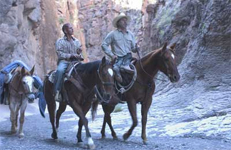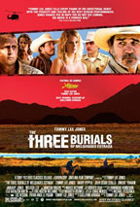The Three Burials of Melquiades Estrada
|  Set in the dusty spaces between the U.S. and Mexico, Tommy Lee Jones’s The Three Burials of Melquiades Estrada is a modern Western that takes the traditional epic journey narrative and subverts it to the whims of black comedy and a strong, but never heavy-handed, critique of the American treatment of illegal immigrants. Set in the dusty spaces between the U.S. and Mexico, Tommy Lee Jones’s The Three Burials of Melquiades Estrada is a modern Western that takes the traditional epic journey narrative and subverts it to the whims of black comedy and a strong, but never heavy-handed, critique of the American treatment of illegal immigrants.The screenplay by Guillermo Arriaga uses a nonlinear structure similar to the ones he deployed in his acclaimed films Amores perros(2000) and 21 Grams (2003), which makes the opening passages of the film vaguely incoherent, but still resolutely intriguing. As the film draws us in, the pieces of the narrative come together and it soon becomes evident that it is at its heart a revenge parable that may or may not be moving toward some kind of redemption (the question of whether or not redemption will be attained keeps it from becoming a cliché, much as John Ford did in The Searchers). Jones stars as Pete Perkins, a grizzled ranch foreman who befriends the titular character, Melquiades Estrada (Julio Cesar Cedillo), an illegal immigrant who crossed the border looking for work to support the family he left behind in Mexico years earlier. The final character in the triangle is Mike Norton (Barry Pepper), a rookie U.S. border patrol officer who recently moved from Cincinnati with his child-like wife, Lou Ann (January Jones). For reasons that aren’t fully explicated until well past the film’s midway point, Norton shoots and kills Melquiades. The local sheriff (Dwight Yoakam) refuses to look into the matter, blithely dismissing it as the simple killing of a “wetback” who, for all intents and purposes, might as well have never existed in the first place. Pete refuses to let it go, and with information gleaned from a waitress at the local diner (Melissa Leo), he learns that Norton was responsible for the killing. In order to make good on a promise he made to Melquiades that he would be buried in his small hometown in Mexico, Pete kidnaps Norton and forces him to exhume Melquiades’s corpse from the virtually unmarked grave given to him by the U.S. authorities and then transport it via horseback into Mexico. Thus, the second half of the film is largely given over to this perverse journey, which has a noble intention (making good on a promise between best friends), but is nonetheless a twisted variation on the traditional Western’s love of wandering as a metaphor for the divide between civilization and the wilderness. The journey itself is meant to redeem Norton for his sin of killing Melquiades, and Pete insures that he suffers along the way, tearing him down from the cocky, self-possessed cad we see at the beginning of the film (his disregard for everyone but himself is uncomfortably driven home in the way he sexually possesses his wife as little more than an object). It is in this regard that the film is at its weakest because Norton is such a clearly demarcated character, with nary a redeeming value. How challenging would the film have been if he had been a more conflicted character, which would have then cast a darker pall on Pete’s enforced journey? Even with that weakness, though, The Three Burials of Melquiades Estrada is a remarkable film, especially give the fact that Jones is making his feature film debut as a director (his only previous stint behind the camera was a made-for-TV Western called The Good Old Boysin 1995). Those who appreciate the gritty work of such American iconoclasts as Sam Peckinpah, John Huston, and Budd Boetticher will immediately recognize the wellspring of Jones’ inspiration, although he was also apparently inspired by the French New Wave work of Jean-Luc Godard and the existential writings of philosopher Albert Camus. Jones and cinematographer Chris Menges, who has shot a number of visually stunning films including The Mission (1986) and Michael Collins (1996), make great use of the wide ’Scope frame, giving the film an overtly epic feel while maintaining the internal focus on the characters and their dilemmas. Jones has a great feel for landscape, and he makes the rocky terrain along the border into outward expression of his characters’ tortured inner lives. Despite the grandeur of the landscape, it consistently brings to mind feelings of alienation and despair, which we see in the lives of all the characters except the relationship between Pete and Melquiades, which is what makes the latter’s senseless killing so profoundly tragic. Yet, for all of the film’s heavy overtones, Jones maintains a sharp balance between the dramatic and blackly comedic, never losing sight of the fact that his mock-epic journey is just a few tones shy of a Monty Python skit. Melquiades’ corpse becomes a virtual character, at turns humorous, disgusting, and heartbreaking, which is, in the end, a perfect compendium of adjectives to describe the film itself. Copyright ©2006 James Kendrick Thoughts? E-mail James Kendrick All images copyright ©2006 Sony Pictures Classics |
Overall Rating: 


 (3.5)
(3.5)


